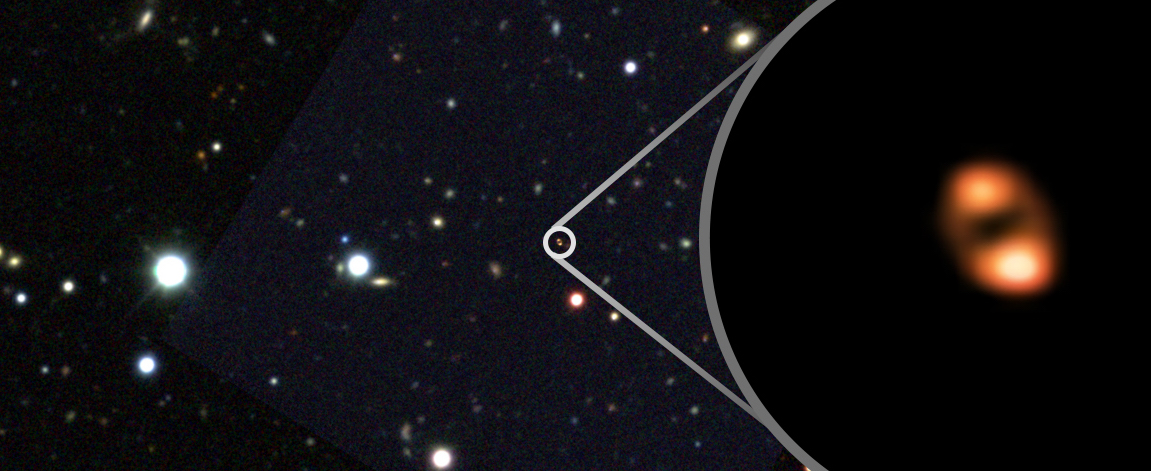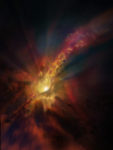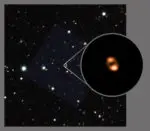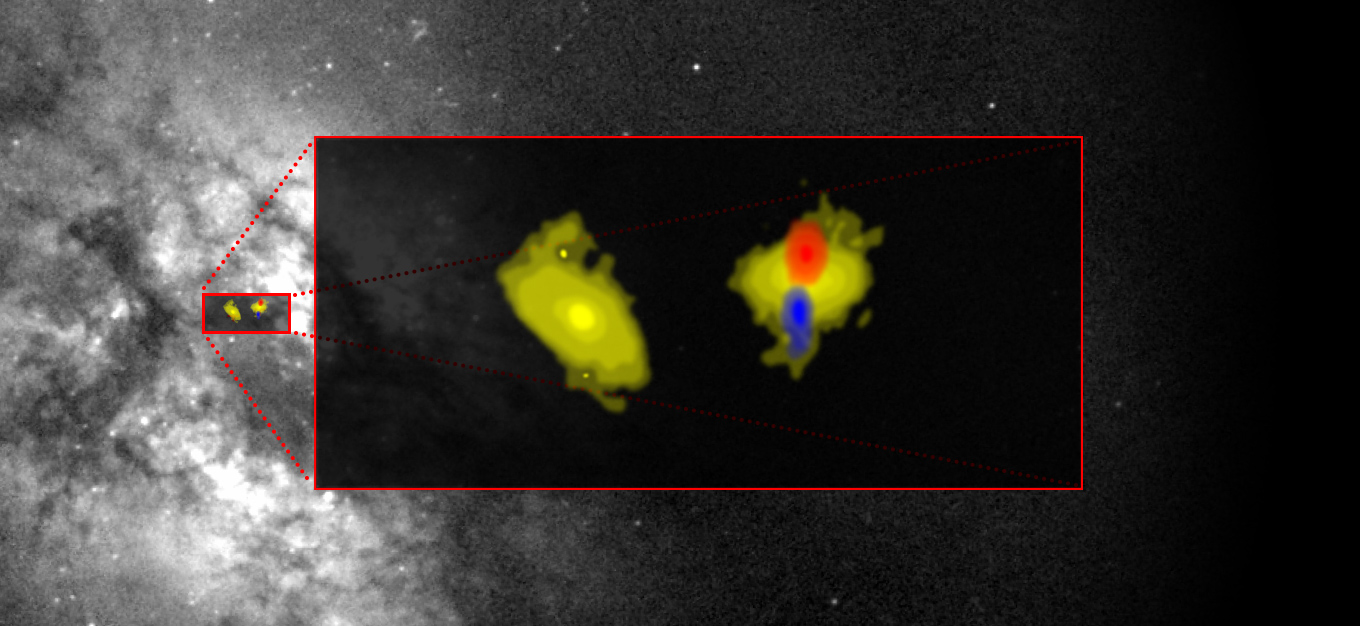Fierce Winds Quench Wildfire-like Starbirth in Far-flung Galaxy
Astronomers using ALMA, with the aid of a gravitational lens, havedetected the most-distant galactic “wind” of molecules ever observed, seen when the universe was only one billion years old. By tracing the outflow of hydroxyl (OH) molecules, which herald the presence of star-forming gas in galaxies, the researchers show how some galaxies in the early universe quenched an ongoing wildfire of starbirth.
Some galaxies, like the Milky Way and Andromeda, have relativelyslow and measured rates of starbirth, with about one new star igniting each year. Other galaxies, known as starburst galaxies, forge 100s or even 1000s of stars each year. This furious pace, however, cannot be maintained indefinitely.
To avoid burning out in a short-lived blaze of glory, some galaxies throttle back their runaway starbirth by ejecting, at least temporarily, vast stores of gas into their expansive halos, where the gas either escapes entirely or slowly rains back in on the galaxy, triggering future bursts of star formation.
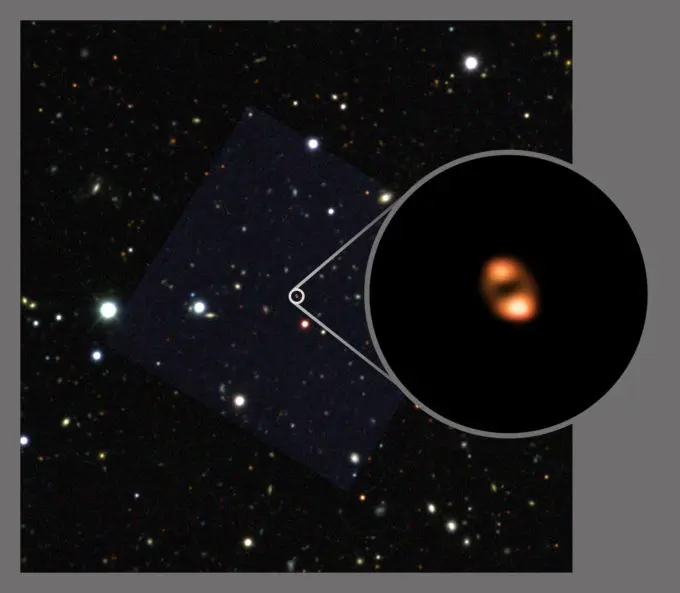
ALMA, aided by a gravitational lens, imaged the outflow, or "wind", from a galaxy seen when the universe was only one billion years old. The ALMA image (circle call out) shows the hydroxyl (OH) molecules. These molecules trace the location of star-forming gas as it is fleeing the galaxy, driven by a supernova or black-hole powered “wind.” The background star field (Blanco Telescope Dark Energy Survey) shows the location of the galaxy. The circular, double-lobe shape of the distant galaxy is due to the distortion caused by cosmic magnifying effect of an intervening galaxy. Credit: ALMA (ESO/NAOJ/NRAO), Spilker; NRAO/AUI/NSF, S. Dagnello; AURA/NSF
Up to now, however, astronomers have been unable to directly observe these powerful outflows in the very early universe, where such mechanisms are essential to prevent galaxies from growing too big, too fast.
New observations with the Atacama Large Millimeter/submillimeter Array (ALMA), show, for the first time,a powerfulgalactic “wind” of molecules in a galaxy seen when the universe was only one billion years old. This result provides insights into how certain galaxies in the early universe were able to self-regulate their growth,so they could continue forming stars across cosmic time.
“Galaxies are complicated, messy beasts, and we think outflows and winds are critical pieces to how they form and evolve, regulating their ability to grow,” said Justin Spilker, an astronomer at the University of Texas at Austin and lead author on a paper appearing in the journal Science.
Astronomers have observed winds with the same size, speed, and mass in nearby starbursting galaxies, but the new ALMA observation is the most distant unambiguous outflow ever seen in the early universe.
The galaxy, known as SPT2319-55, is more than 12 billion light-years away. It was discovered by the National Science Foundation’s South Pole Telescope.
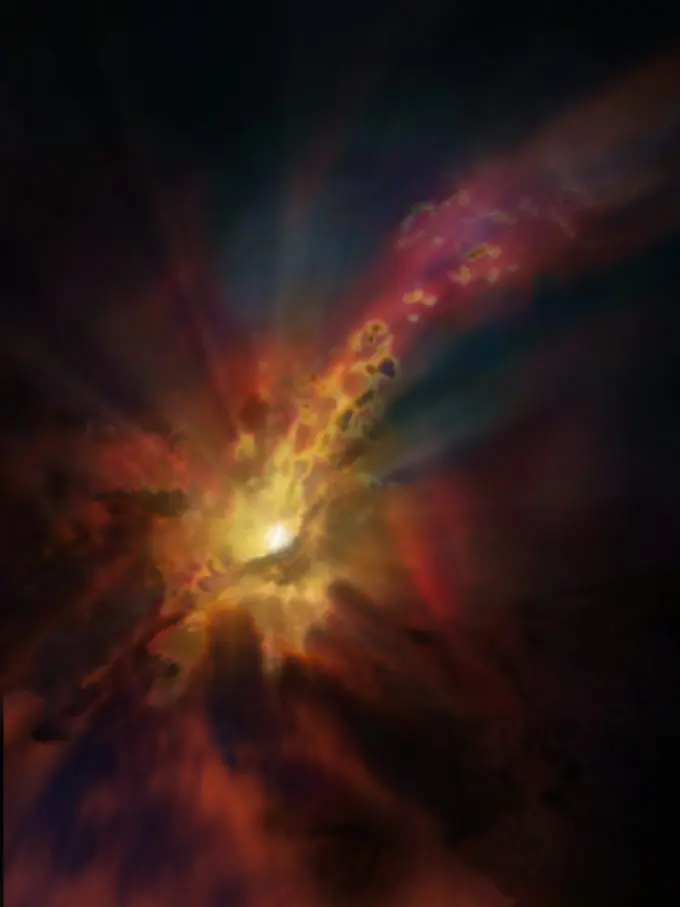
Artist impression of an outflow of molecular gas from an active star-forming galaxy. Credit: NRAO/AUI/NSF, D. Berry
ALMA was able to observe this object at such tremendous distance with the aid of a gravitational lens provided by a different galaxy that sits almost exactlyalong the line of sight between Earth and SPT2319-55. Gravitational lensing – the bending of light due to gravity — magnifies the background galaxy to make it appear brighter, which allows the astronomers to observe it in more detail than they would otherwise be able to. Astronomers use specialized computer programs to “unscramble” the effects of gravitational lensing to reconstruct an accurate image of the more-distant object.
This lens-aided view revealed a powerful“wind” of star-forming gas exiting the galaxy at nearly 800 kilometers per second. Rather than a constant, gentle breeze, the wind is hurtling away in discrete clumps, removing the star-forming gas just as quickly as the galaxy can turn that gas into new stars.
The outflow was detected by the millimeter-wavelength signature of a molecule called hydroxyl (OH), which appeared as an absorption line: essentially, the shadow of an OH fingerprint in the galaxy’s bright infrared light.
As new, dust-enshrouded stars form, that dust heats up and glows brightly in infrared light. However, the galaxy is also launching a wind, and some of it is blowing in our direction. As the infrared light passes through the wind on its journey toward Earth, the OH molecules in the wind absorb some of the infrared light at a very particular wavelength that ALMA can observe.
“That’s the absorption signature that we detected, and from that, we can also tell how fast the wind is moving and get a rough idea of how much material is contained in the outflow,” said Spilker. ALMA can detect this infrared light because e it has been stretched to millimeter wavelengths on its journey to Earth by the ongoing expansion of the Universe.
Molecular winds are an efficient way for galaxies to self-regulate their growth, the researchers note. These winds are likely triggered by either the combined effectof all the supernova explosions that go along with rapid, massive star formation or by a powerful release of energy as some of the gas in the galaxy falls down onto the supermassive black hole at its center.
“So far, we have only observed one galaxy at such a remarkable cosmic distance, but we’d like to know if winds like these are also present in other galaxies to see just how common they are,” concluded Spilker. “If they occur in basically every galaxy, we know that molecular winds are both ubiquitous and also a prevalent way for galaxies to self-regulate their growth.”
“This ALMA observation demonstrates how nature coupled with exquisite technology can give us insights into distant astronomical objects,” said Joe Pesce, NSF Program Director for NRAO/ALMA, “and the frequency range accessible to ALMA meant it was able to the detect the redshifted spectral feature from this important molecule.”
Additional Information
This research is presented in a paper titled “Fast Molecular Outflow from a Dusty Star-Forming Galaxy in the Early Universe,” by J.S. Spilker et al. in the journal Science. [https://www.science.org]
The research team was composed by J. S. Spilker [1,2,∗],M. Aravena [3], M. Béthermin [4], S. C. Chapman [5], C.-C. Chen [6], D. J. M. Cunningham [5,7], C. De Breuck [6], C. Dong [8], A. H. Gonzalez [8], C. C. Hayward [9,10], Y. D. Hezaveh [11], K. C. Litke [2], J. Ma [12], M. Malkan [13], D. P. Marrone [2], T. B. Miller [5,14], W. R. Morningstar [11], D. Narayanan [8], K. A. Phadke [15], J. Sreevani [15], A. A. Stark [10], J. D. Vieira [15], A. Weiß [16].
[1] Department of Astronomy, University of Texas at Austin, 2515 Speedway Stop C1400, Austin, TX 78712, USA.
[2] Steward Observatory, University of Arizona, 933 North Cherry Avenue, Tucson, AZ 85721, USA.
[3] Núcleo de Astronomía, Facultad de Ingeniería, Universidad Diego Portales, Av. Ejército 441, Santiago, Chile.
[4] Aix-Marseille Univ., Centre National de la Recherche Scientifique, Laboratoire d’Astrophysique de Marseille, Marseille, France.
[5] Department of Physics and Atmospheric Science, Dalhousie University, Halifax, Nova Scotia, Canada.
[6] European Southern Observatory, Karl Schwarzschild Straße 2, 85748 Garching, Germany.
[7] Department of Astronomy and Physics, Saint Mary’s University, Halifax, Nova Scotia, Canada.
[8] Department of Astronomy, University of Florida, Bryant Space Sciences Center, Gainesville, FL 32611, USA.
[9] Center for Computational Astrophysics, Flatiron Institute, 162 Fifth Avenue, New York, NY 10010, USA.
[10] Harvard-Smithsonian Center for Astrophysics, 60 Garden Street, Cambridge, MA 02138, USA.
[11] Kavli Institute for Particle Astrophysics and Cosmology, Stanford University, Stanford, CA 94305, USA.
[12] Department of Physics and Astronomy, University of California, Irvine, CA 92697, USA
[13] Department of Physics and Astronomy, University of California, Los Angeles, CA 90095, USA.
[14] Department of Astronomy, Yale University, 52 Hillhouse Avenue, New Haven, CT 06511, USA.
[15] Department of Astronomy, University of Illinois, 1002 West Green St., Urbana, IL 61801, USA.
[16] Max-Planck-Institut für Radioastronomie, Auf dem Hügel 69 D-53121 Bonn, Germany.
∗Corresponding author. E-mail: [email protected].
The Atacama Large Millimeter/submillimeter Array (ALMA), an international astronomy facility, is a partnership of the European Southern Observatory (ESO), the U.S. National Science Foundation (NSF) and the National Institutes of Natural Sciences (NINS) of Japan in cooperation with the Republic of Chile. ALMA is funded by ESO on behalf of its Member States, by NSF in cooperation with the National Research Council of Canada (NRC) and the Ministry of Science and Technology (MOST) in Taiwan and by NINS in cooperation with the Academia Sinica (AS) in Taiwan and the Korea Astronomy and Space Science Institute (KASI).
ALMA construction and operations are led by ESO on behalf of its Member States; by the National Radio Astronomy Observatory (NRAO), managed by Associated Universities, Inc. (AUI), on behalf of North America; and by the National Astronomical Observatory of Japan (NAOJ) on behalf of East Asia. The Joint ALMA Observatory (JAO) provides the unified leadership and management of the construction, commissioning and operation of ALMA.
Contacts
-
Nicolás Lira
Education and Public Outreach CoordinatorJoint ALMA Observatory, Santiago - ChilePhone: +56 2 2467 6519Cel: +56 9 9445 7726Email: [email protected] -
Charles E. Blue
Public Information OfficerNational Radio Astronomy Observatory Charlottesville, Virginia - USAPhone: +1 434 296 0314Cel: +1 202 236 6324Email: [email protected] -
Calum Turner
ESO Assistant Public Information Officer -
Masaaki Hiramatsu
Education and Public Outreach Officer, NAOJ Chile
